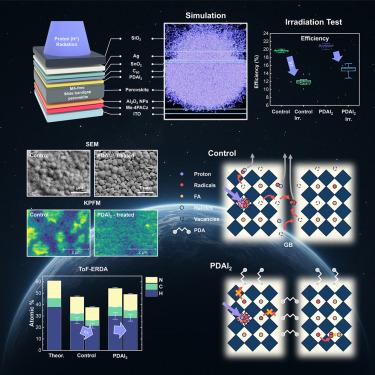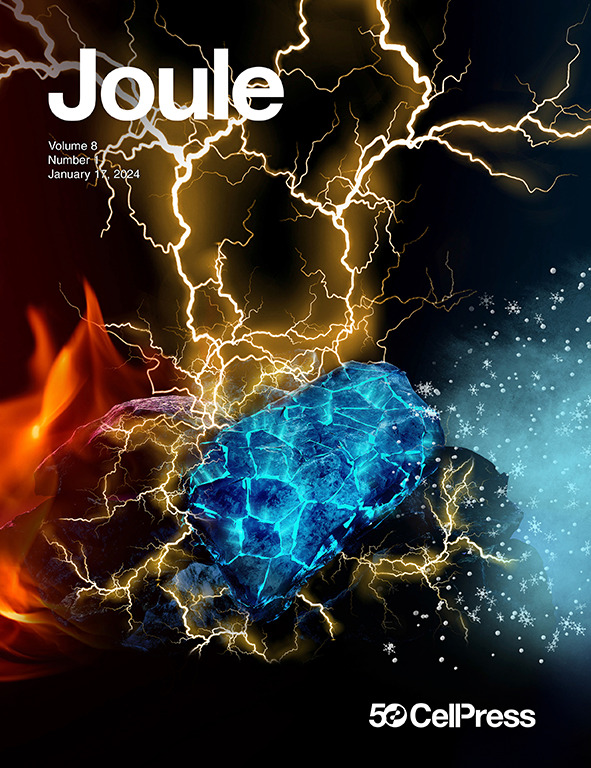Enhancing radiation resilience of wide-band-gap perovskite solar cells for space applications via A-site cation stabilization with PDAI2
IF 35.4
1区 材料科学
Q1 CHEMISTRY, PHYSICAL
引用次数: 0
Abstract
Perovskite solar cells (PSCs) for space applications have garnered significant attention due to their high tolerance to proton radiation. While the self-healing mechanism of PSCs is largely attributed to mobile inorganic halide ions, the effects of radiation on organic A-site cations remain underexplored. In this study, wide-band-gap Cs/formamidinium (FA) PSCs, which are promising for tandem applications in space environments, were subjected to harsh proton radiation testing. Photovoltaic (PV) device parameters of the PSCs measured pre- and post-irradiation demonstrated that propane-1,3-diammonium iodide (PDAI2) treatment effectively mitigates radiation-induced damage to the perovskite layer. Advanced characterization techniques, including X-ray photoelectron spectroscopy (XPS) depth profiling using femtosecond laser ablation (fs-LA) and time-of-flight elastic recoil detection analysis (ToF-ERDA), were employed to analyze the impact of proton radiation on A-site organic cations. Additionally, time-resolved Kelvin probe force microscopy (tr-KPFM) was utilized to elucidate the mechanism by which PDAI2 treatment mitigates proton-induced damage to the organic cations.


利用PDAI2稳定a位阳离子增强空间应用宽带隙钙钛矿太阳能电池的辐射弹性
钙钛矿太阳能电池(PSCs)由于其对质子辐射的高耐受性而引起了人们的广泛关注。虽然psc的自愈机制主要归因于可移动的无机卤化物离子,但辐射对有机a位阳离子的影响仍未得到充分研究。在这项研究中,宽带隙Cs/formamidinium (FA) PSCs进行了苛刻的质子辐射测试,该PSCs有望在空间环境中串联应用。辐照前后测量的光伏(PV)器件参数表明,丙烷-1,3-碘化二铵(PDAI2)处理可有效减轻辐射引起的钙钛矿层损伤。利用x射线光电子能谱(XPS)飞秒激光烧蚀深度分析(fs-LA)和飞行时间弹性后坐力检测分析(ToF-ERDA)等先进表征技术,分析了质子辐射对a位有机阳离子的影响。此外,利用时间分辨开尔文探针力显微镜(r- kpfm)来阐明PDAI2处理减轻质子诱导的有机阳离子损伤的机制。
本文章由计算机程序翻译,如有差异,请以英文原文为准。
求助全文
约1分钟内获得全文
求助全文
来源期刊

Joule
Energy-General Energy
CiteScore
53.10
自引率
2.00%
发文量
198
期刊介绍:
Joule is a sister journal to Cell that focuses on research, analysis, and ideas related to sustainable energy. It aims to address the global challenge of the need for more sustainable energy solutions. Joule is a forward-looking journal that bridges disciplines and scales of energy research. It connects researchers and analysts working on scientific, technical, economic, policy, and social challenges related to sustainable energy. The journal covers a wide range of energy research, from fundamental laboratory studies on energy conversion and storage to global-level analysis. Joule aims to highlight and amplify the implications, challenges, and opportunities of novel energy research for different groups in the field.
 求助内容:
求助内容: 应助结果提醒方式:
应助结果提醒方式:


